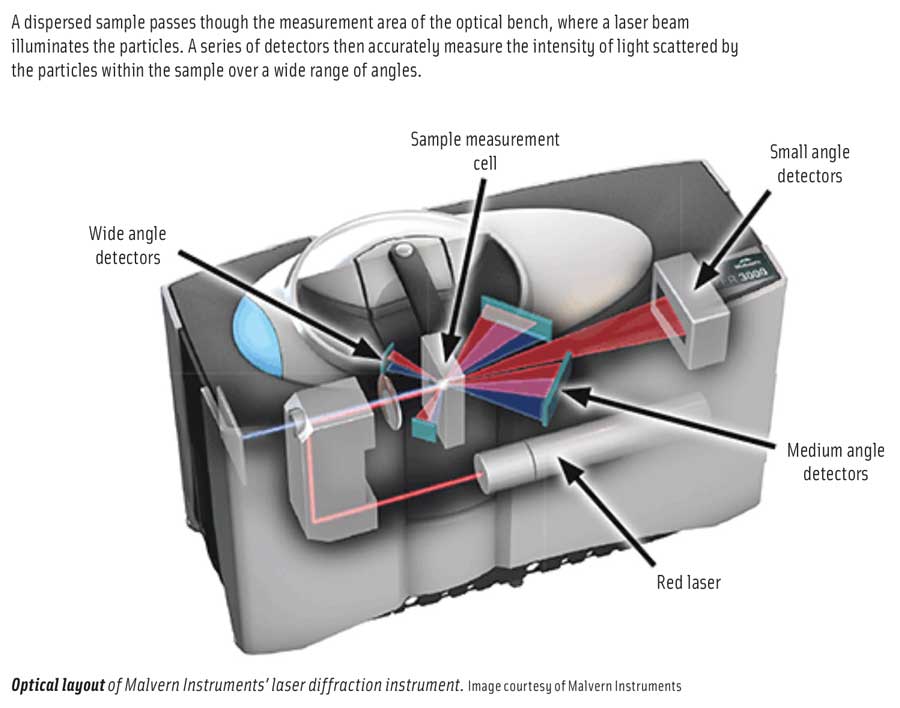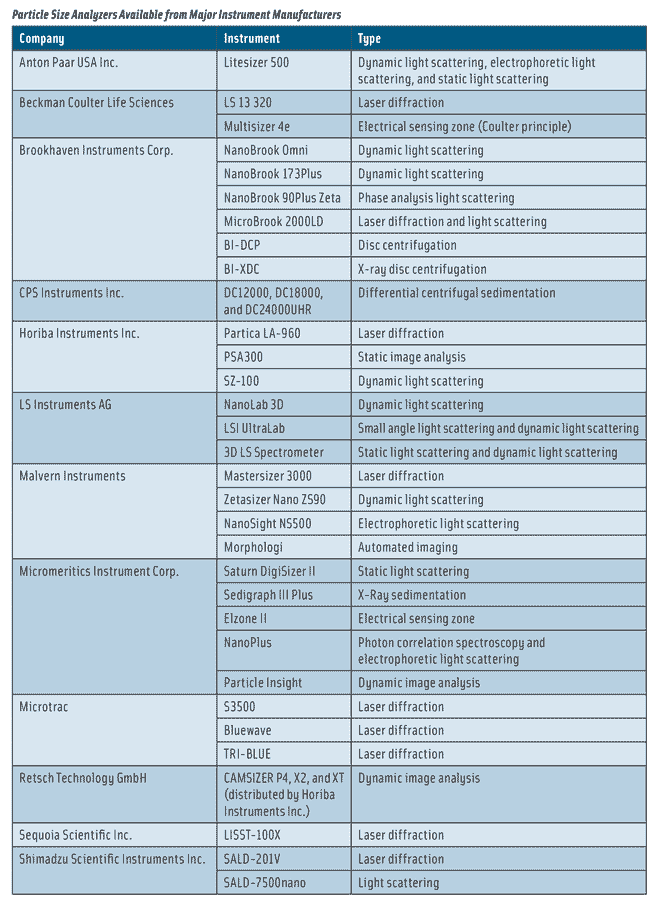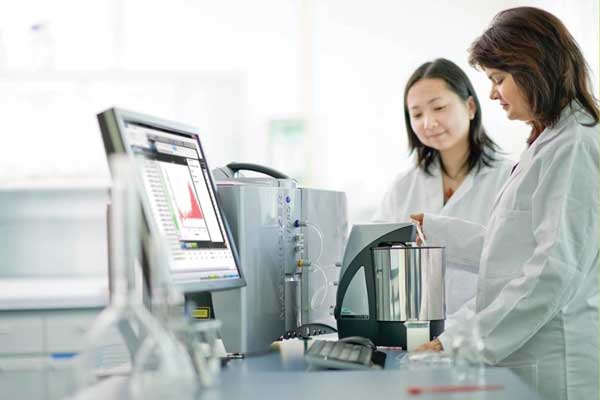Sizing Up Particles
FOOD SAFETY & QUALITY
 Particle size analysis is important in many industries. Knowledge of particle size is important in the food industry because it affects the production and handling of ingredients and the formulation, processing, and quality control of food and beverage products. Particle size affects reactivity, solubility, and flowability of ingredients and the texture, mouthfeel, and processing of products. Particle size analysis has been applied to a wide variety of ingredients and products, including coffee, sugar, salt, flour, chocolate, milk powder, spices, and flavors. Analytical techniques for measuring particle size range from traditional sieving and sedimentation to use of modern automated imaging and laser-based instruments.
Particle size analysis is important in many industries. Knowledge of particle size is important in the food industry because it affects the production and handling of ingredients and the formulation, processing, and quality control of food and beverage products. Particle size affects reactivity, solubility, and flowability of ingredients and the texture, mouthfeel, and processing of products. Particle size analysis has been applied to a wide variety of ingredients and products, including coffee, sugar, salt, flour, chocolate, milk powder, spices, and flavors. Analytical techniques for measuring particle size range from traditional sieving and sedimentation to use of modern automated imaging and laser-based instruments.
Sieving
Sieving is the traditional method for determining the size distribution of a sample of solid material. A dry sample is placed in the top sieve of a stack of sieves of decreasing aperture sizes, and the stack is vibrated to separate the different sizes by gravity. Then the sieves are weighed to determine the size distribution. Sieving is commonly used with relatively large materials, greater than 63 microns in diameter.
Sedimentation
Sedimentation velocity of suspended particles can be obtained by measuring the concentration of particles remaining in suspension with time. Sedimentation can be either gravitational or centrifugal. Gravitational sedimentation is normally limited to particles of relatively large size because the rate of sedimentation for small particles is too low to give a practical analysis time and because Brownian motion of small particles becomes too large to allow effective settling. In this method, also called integral sedimentation, a beam of light or X-rays is passed through a fluid sample at a known distance from the fluid surface to measure particle concentration. As particles settle through the fluid, the concentration of particles remaining in the dispersion falls, and the intensity of light or X-rays that reaches the detector increases. Stokes’ law is used to calculate the size of particles that settle out of the fluid as a function of time, and a particle size distribution is generated by plotting the measured concentration of particles against the calculated particle diameter.
In centrifugal sedimentation, also called differential centrifugal sedimentation, a sample is placed on top of a column of clear liquid in an optically clear rotating disc and forms a thin film that spreads radially over the surface of the liquid due to centrifugal force. As the particles reach the edge of the disc, they block the beam of light. The change in light intensity is recorded and converted into a particle size distribution.
Electrical Sensing
The electrical sensing zone technique, also known as the Coulter Principle, measures the changes in impedance as particles suspended in a conductive fluid pass through a small aperture. A tube with a small aperture on its wall is immersed into a beaker containing particles suspended in an electrolyte. Two electrodes are placed into the beaker, one inside the tube and one outside the tube, and an electric field is applied, creating a current. As a particle passes through the aperture, it displaces an equivalent volume of electrolyte from the sensing zone, causing a change in the impedance across the orifice that can be measured as a voltage pulse or a current pulse, the height of which is proportional to the volume or mass of the particle. Using count and pulse height analyzer circuits, the number of particles and volume of each particle passing through the aperture can be measured. This technique is commonly used for counting bacteria and cells, such as yeast in brewing.

Image Analysis
Image analysis is extensively used in the food industry. There are two types: static and dynamic. In static image analysis, a nonmoving sample, such as a sample prepared on a slide, is viewed through a microscope and camera and the particles measured directly. The method can be automated by moving the slides past the microscope and camera. In dynamic image analysis, a sample of particles is suspended in a carrier liquid in a thin flow cell, and light transmitted through the flow cell projects silhouettes of the particles onto a camera sensor as they move past the sensor. The high frame rate and high resolution of the sensor enable construction of statistically representative particle size distributions by analyzing thousands of particles per measurement. Processing machines such as those for sorting stones from nuts, for example, often employ some form of dynamic image analysis.
Light Scattering
The size of particles can be determined by the way they scatter light. There are two types: static and dynamic, both based on the equivalent sphere concept. Unless particles are perfect spheres, such as emulsions or bubbles, they can’t be fully described by a single dimension, such as a radius or diameter. To simplify measurement and reporting, light-scattering instruments generally consider particles as a sphere having the same volume or mass as the actual particle. The concept works very well for regular-shaped particles, but irregular-shaped particles present challenges for measurement and data analysis. Other particle sizing techniques besides light scattering techniques also use some form of equivalent. Unless every particle in a sample has the same dimensions, it will consist of a statistical distribution of particles of different sizes. The distribution is generally presented as a frequency distribution curve, from which the range, mean, median, and mode can be determined and reported.
--- PAGE BREAK ---
In static light scattering, also known as laser diffraction, a monochromatic beam of laser light is passed through a collimator and focused on a sample of particles in dispersion. The particles scatter light, and the intensity at one or more angles is detected by a photodetector array and mathematically converted by complex algorithms to provide a particle size distribution. Larger particles scatter light at small angles, and smaller particles scatter light at wide angles.
Laser diffraction analyzers are used for measuring particles with diameters of 10 nm to 3 mm. The advantages of laser diffraction over other techniques are speed of analysis, application flexibility, small particle accuracy, and ease of use. It can measure nano-, micro-, and macro-sized powders, suspensions, and emulsions rapidly (within minutes). Common applications are dairy products, chocolate, grains, coffee, and spices.
Dynamic light scattering (DLS), also known as photon correlation spectroscopy, determines particle size distribution from the fluctuations in scattered light caused by the Brownian motion of the particles. A laser beam is focused on the sample, and a single detector, traditionally placed at 90 degrees to the laser beam, collects the intensity of the light scattered by the particles at all angles. The intensity fluctuations of the scattered light are converted into electrical pulses from which the particle size distribution is calculated. In some instruments, backscatter detection by another detector at 173 degrees extends the range of sizes that can be measured. DLS analyzers are used for measuring particles with diameters of 0.6 nm to 6 µm. They have been used in the flavoring industry and also to look at haze in beer and fruit juices.
The electrostatic attraction or repulsion between particles in a liquid suspension is termed zeta potential. Most particulate materials in contact with a liquid acquire an electronic charge on their surfaces. Since charged particles repel each other and overcome the tendency to aggregate, knowledge of the zeta potential is useful in the formulation of dispersions, emulsions, and suspensions. The greater the zeta potential, the greater the particle stability.
Zeta potential is generally measured by electrophoretic light scattering (ELS). A dispersion of particles is introduced into a cell containing two electrodes, and an electrical field is applied to the electrodes. Any charged particles or molecules will migrate toward the electrode with the opposite charge. The velocity with which they migrate is measured by either of two laser Doppler techniques. One determines a frequency shift and gives a full zeta potential distribution, and the other measures the phase shift and gives an average zeta potential value. Some instruments combine DLS and ELS to measure both particle size and zeta potential.
The Particle Size Analysis Market
The global particle size analysis market is expected to be worth $256.1 million by 2021, according to a May 2016 report by the market research firm MarketsandMarkets. Malvern Instruments Ltd., Malvern, United Kingdom (malvern.com), is the market leader, followed by Beckman Coulter, Indianapolis, Ind. (beckmancoulter.com); Horiba Instruments Inc., Irvine, Calif. (horiba.com); Microtrac, Montgomeryville, Pa. (microtrac.com); and others. The manufacturers provide via their websites much information on particle size analysis, including brochures, white papers, webinars, videos, and application notes. The table on p. 70 lists some of the instruments the major manufacturers offer.
 Alan Rawle, applications manager at Malvern Instruments and co-chair of the E56.02 Characterization Subcommittee of the ASTM E56 Committee on Nanotechnology, said the major consideration concerning which technique to use for a particular application is basically whether it will provide the information required to predict product performance or assess product quality. Representative sampling and sample preparation are important, he said. Typically, the sample preparation techniques for these instruments, except for sieving, require high dilution, and care needs to be taken that the dilution is done correctly, especially with emulsions. Technical challenges in all instrumentation fields are and will be mainly in the software area, he said, as one can’t change the basic laws of physics.
Alan Rawle, applications manager at Malvern Instruments and co-chair of the E56.02 Characterization Subcommittee of the ASTM E56 Committee on Nanotechnology, said the major consideration concerning which technique to use for a particular application is basically whether it will provide the information required to predict product performance or assess product quality. Representative sampling and sample preparation are important, he said. Typically, the sample preparation techniques for these instruments, except for sieving, require high dilution, and care needs to be taken that the dilution is done correctly, especially with emulsions. Technical challenges in all instrumentation fields are and will be mainly in the software area, he said, as one can’t change the basic laws of physics.
There has always been a demand for smaller devices that require less lab bench real estate, and these have been faster, smarter, and capable of delivering more bang for the buck, Rawle said. However, software is always where the strengths or weaknesses of any system are perceived, he added. Users may not be able to spend a lot of time getting familiar with all the ins and outs of a system from theory to practice, so software needs to be smart and recognize what a user needs. There is always a balance between providing ease of use and functionality together with advanced features and flexibility.
Education and training have always been important and always will be, he said. Context-sensitive help, 24-hour support worldwide, on-demand webinars, regular face-to-face user training sessions, and application notes specific to users’ needs are all items that need to be factored into an instrument’s final price these days. The partnership between manufacturers and users, Rawle said, relies on quality and speed of support, the latter being vital in a fast-moving world.
 Neil H. Mermelstein, IFT Fellow,
Neil H. Mermelstein, IFT Fellow,
Editor Emeritus of Food Technology
[email protected]


